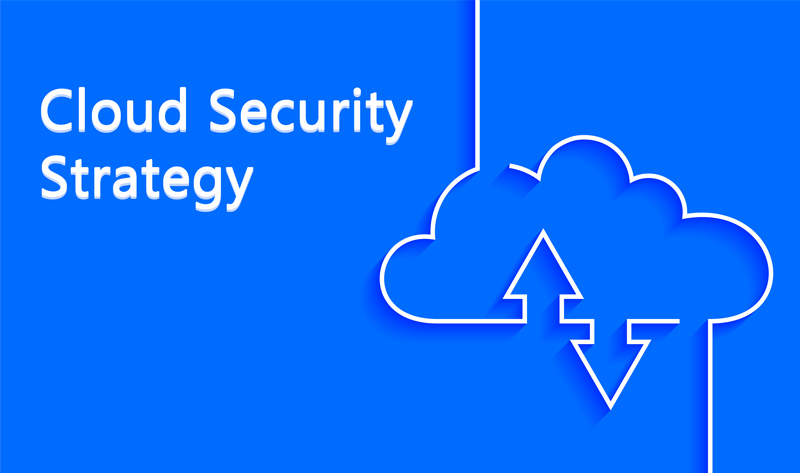What Is a Cloud Security Strategy & 11 Essentials
What Is a Cloud Security Strategy and Its Significance?
Here, we discuss a cloud security strategy and its types, aspects, and the essential elements required to set it up. Enterprises worldwide have shifted to cloud computing as it offers flexibility, extensibility, and agility. Hence, cloud security is essential to secure the network infrastructure and data. For this, you require a robust cloud security strategy, i.e., a set of policies, practices, and technologies developed to safeguard your cloud data and infrastructure.
A solid strategy to secure and monitor the cloud assets and tools confines various crucial elements, including data protection, threat mitigation, risk management, and data recovery, to strengthen the overall cybersecurity of an enterprise.
● Data Protection: It helps to define and execute measures to safeguard sensitive data.
● Threat Mitigation: Cloud security strategy aids threat mitigation by identifying and eliminating potential cyber security threats.
● Risk Management: It analyzes and reduces the possibility of any cloud security risk.
● Data Recovery: In case of any sensitive data loss, a potent cloud security strategy assures fast and efficient recovery of the lost data.

5 Types of Cloud Security Strategy and Subclass
There are various types and subclasses of cloud security strategy. Enterprises must understand each of them to tailor their approach to specific security requirements. Five types of cloud security strategies are listed below.
Cloud Security Strategy Types
- Public Cloud Security Strategy: Safeguards public cloud environment provided by a third-party cloud service provider.
- Private Cloud Security Strategy: Focuses on securing the infrastructure in a private cloud environment.
- Hybrid Cloud Security Strategy: Ensures security measures in a hybrid cloud environment comprising public and private cloud infrastructure.
- Multi-Cloud Security Strategy: Secures a multi-cloud environment that uses multiple cloud service providers.
- Community Cloud Security Strategy: Personalized strategy for the shared cloud environment among multiple enterprises of similar interest.
Along with the multiple types, there are also some subclasses of cloud security strategy. Below, we have listed them.
Subclasses of Cloud Security Strategy
- Cloud Migration Security Strategy:Safeguards data and other network elements while migrating to the cloud.
- Cloud Security Monitoring Strategy: Constantly monitor cloud resources to find any possible risk or threat that can cause a security breach.
- Cloud Access Security Strategy: Emphasizes controlling, limiting, and authenticating the user access to the cloud environment.
- Cloud Compliance Strategy: Focuses on the adherence and compliance of the set standards for the cloud infrastructure.
- Cloud Data Protection Strategy: Helps to secure the cloud data by encrypting it and applying access authentication.
All the above types and subclasses of cloud security strategies are integral in tackling specific security issues, offering an all-inclusive framework to secure sensitive data and other elements in diverse cloud environments.
Key Aspects a Cloud Security Strategy Should Cover
It is not enough to have a strategy for cloud security. It should be comprehensive to secure the enterprise network infrastructure and data. It must cover the following key aspects.
Data Protection
One of the critical aspects of a cloud security strategy is data protection to secure all the data in transit or at rest. It includes the following things:
- Data Encryption
- Data Loss Prevention (DLP)
- Data Backup and Recovery
Access Control
Identity verification, authentication, and access control are crucial elements of cloud security strategy and prevent unauthorized access. It includes:
- Identity and Access Management (IAM)
- Least Privilege (Role Based Access)
- User Activity Monitoring
Network Security
Implementing network security measures is essential to secure the enterprise's cloud and other network infrastructure. Network security involves:
- Using Virtual Private Network (VPN)
- Firewall Implementation
- Intrusion Detection and Prevention Systems (IDPS)
Application Security
Unsecured applications can also be a threat to cloud security. Hence, application security is a crucial part of cloud security strategy. It includes:
- Secure Coding Practices
- Web Application Firewalls (WAFs)
- Regular Software Patching and Updates
Endpoint Security
Compromised endpoint devices pose a threat to the entire cloud environment. Therefore, endpoint security is essential. It includes:
- Endpoint Protection Platforms (EPP)
- Mobile Device Management (MDM)
- Secure Remote Access
Incident Response and Disaster Recovery
Setting up a Response and Disaster Recovery plan is vital to mitigate security risks. It includes things such as:
- Incident Response Plan
- Regular Backups
- Regular Testing and Exercises
Training and Awareness
Human-related cloud security breaches can be avoided by providing proper training and awareness to the users. It includes providing:
- Security Awareness Training
- Policy Awareness
- Ongoing Security Education
Now that we know the critical aspects of a potent cloud security strategy, it is time to discuss the essentials and ways to set it up.

11 Essentials to Set Up a Cloud Security Strategy
Any enterprise must set up a cloud security strategy. The process involves various steps and stages. Below, we have discussed the essential phases and measures to set up an all-inclusive system to secure the cloud data and network infrastructure.
Planning Phase
The initial phase in the process of setting up a comprehensive cloud security strategy is planning. It involves risk assessment, security requirements analysis, and vendor evaluation.
The planning phase helps to forecast and identify possible threats and risks to the cloud environment of the enterprise. It helps to create a robust action plan to mitigate the identified cloud security threats.
1) Risk Assessment
The first thing to do while setting up a strategy to safeguard cloud infrastructure is to assess the risk involved. By performing risk assessment, enterprises can discover possible threats and risks and their severity.
2) Security Requirements Analysis
After assessing the possible risk, the next step is to outline the security requirements, such as data encryption, access controls, and standard compliance to eliminate the threat.
3) Vendor Evaluation
Once the security requirements analysis is complete, there is time to select and evaluate a vendor that offers cloud services complying with the security strategy and standards.
Implementation Phase
The next phase is the implementation of security measures and plans found and formulated in the planning phase. It consists of steps such as implementing security controls, data migration, security policies, and employee training.
4) Security Controls Implementation
In security control implementation, enterprises deploy security measures such as configurations, firewalls, IDPS (Intrusion Detection and Prevention Systems), or IAM (Identity and Access Management System).
5) Data Migration
The next step is data migration. With a potent cloud migration security strategy, enterprises safeguard data and other network elements while migrating to the cloud.
6) Security Policies
Firm policies should govern the usage of cloud resources and prevent any unethical or suspicious activity on the cloud infrastructure.
7) Employee Training
It is essential to give employees proper training to use cloud resources securely. An all-inclusive cloud training eliminates the risk of any security breach due to human error.
Maintenance and Update Phase
Maintenance and update are the last phases of setting up a cloud security and monitoring strategy. It includes monitoring the strategy after implementation, incident response, regular audits, and management of updates and patches.
8) Monitoring
Constant monitoring of the cloud infrastructure and security strategy is essential. It helps to find any breaches or threat possibilities. Enterprises use security monitoring tools like intrusion detection systems to perform real-time analysis.
9) Incident Response
In case of any security incident, enterprises activate the incident response and recovery plan to mitigate the impact and perform successful data recovery.
10) Regular Audits
Testing the efficiency and effectiveness of cloud security measures is necessary and can be done with regular audits of the cloud security strategy and actions performed.
11) Update and Patch Management
Threats are ever-evolving. Hence, to keep the cloud environment secure, it is a must to keep the strategy up-to-date. With updates and patch management, enterprises can keep up with any rising security threat.
In short, proper planning, implementation, maintenance, and update are required to set up an effective cloud security strategy.
Standards for a Good Cloud Security Strategy
Along with being comprehensive and robust, a cloud security strategy must adhere to various other standards, such as regulatory compliance, adaptability, etc., to be considered suitable for an enterprise.
Below, are listed and elaborated key benchmarks for an apt cloud security system. Organizations must consider and check these standards before selecting a strategy for their cloud security.
1Coverage
An apt cloud security strategy should be all-inclusive. It should cover all the aspects of cloud security, including Data Protection, Access Control, Network Security, Application Security, Endpoint Security, Incident Response and Disaster Recovery, and Training & Awareness. Along with these aspects, it should address threats such as DDoS attacks, data leaks, unauthorized access, etc.
2Adaptability
As we know, threats are ever-evolving. Hence, a good cloud security strategy should be flexible to adapt and tackle the changing environment and threats. Not just flexible, the strategy should also be up-to-date to perform the best cloud security practices.
3Regulatory Compliance
A good cloud security strategy should comply with all the regulatory standards, including the data protection rules or other compliances specific to any particular industry. It helps to avoid legal and financial consequences.
4Implementation
Planning without action is futile. Hence, it is not enough to create a cloud security strategy. Its implementation also matters. A good cloud security strategy can help enterprises protect themselves from potential attacks.
5Incident Response
One of the crucial components and standards for a good cloud security strategy is incident response. Enterprises should have an incident response and recovery plan to efficiently reduce the impact of any security incidents that might occur.
Conclusion
The above is cloud security strategy's what, why, and how. In conclusion, a well-crafted and all-inclusive cloud security strategy is necessary for any enterprise utilizing cloud resources. It helps them protect cloud data, mitigate threats, manage risks, and recover lost data.
Still need help? Submit a request >>


